Organizational Effectiveness: Coaching in Leadership Report
VerifiedAdded on 2022/12/30
|22
|5290
|97
Report
AI Summary
This report delves into the multifaceted realm of organizational effectiveness, emphasizing the pivotal role of coaching within organizational cultures. It begins by introducing a systemic approach to coaching, exploring frameworks like OSKAR, GROW, and CLEAR models to develop effective coaching strategies for individuals. The report then examines the development of emotional expression capacity, analyzing various models such as the Basic, Appraisal, Psychological Construction, and Social Construction models. Furthermore, it expands upon trust theory to enhance relationship-building capabilities, discussing theories of interpersonal trust and levels of trust development. The report emphasizes the cultivation of core coaching skills, including listening, inquiry, feedback, and courageous conversations, along with the practical application of peer coaching and performance reviews. It also applies the theory of intra and interpersonal awareness to unlock talent, leverage leadership, and improve performance, while selecting and applying psychological approaches through relevant theory and practice. Finally, the report applies concepts of adult development theory to coaching, providing a comprehensive understanding of the subject.
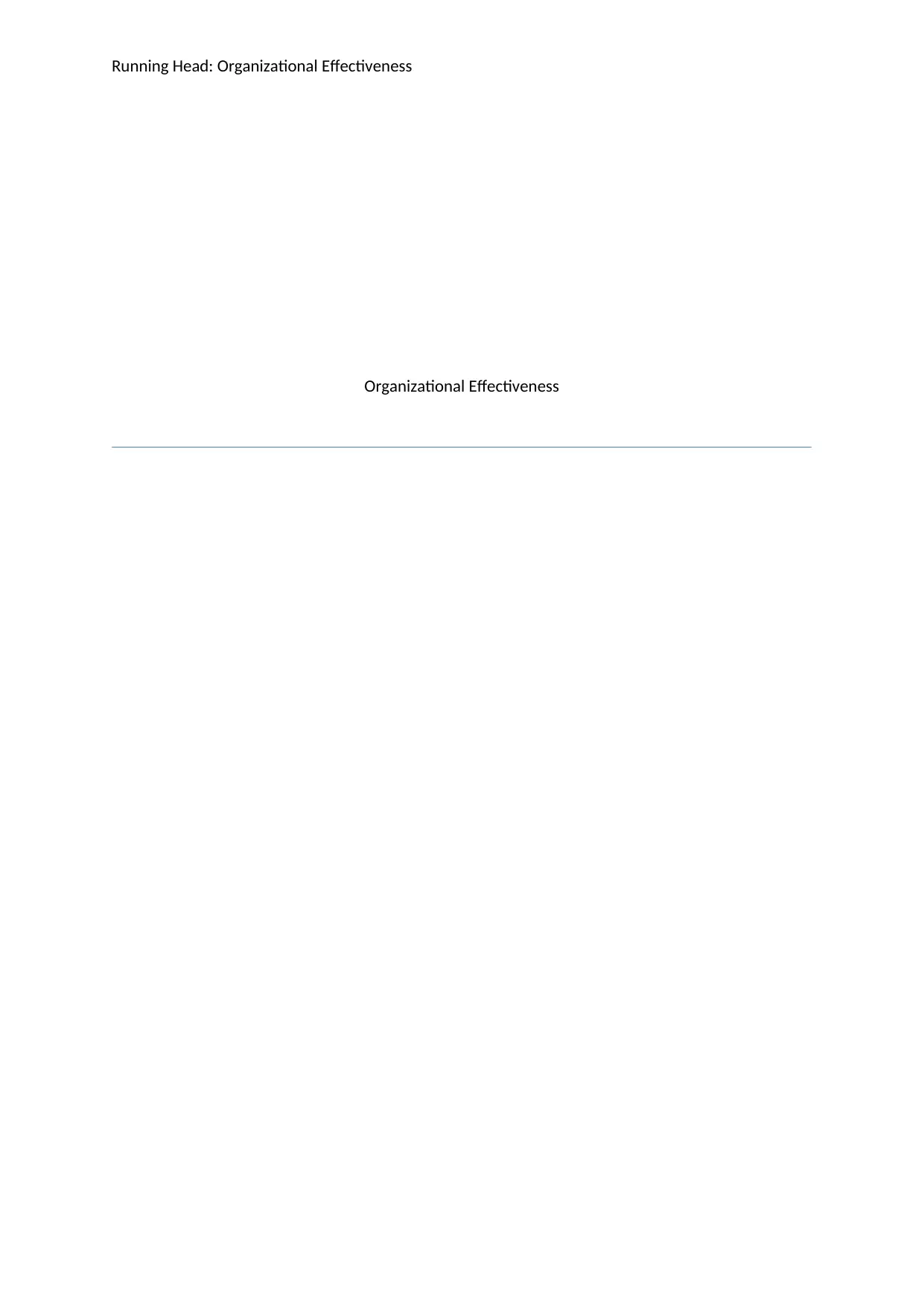
Running Head: Organizational Effectiveness
Organizational Effectiveness
Organizational Effectiveness
Paraphrase This Document
Need a fresh take? Get an instant paraphrase of this document with our AI Paraphraser
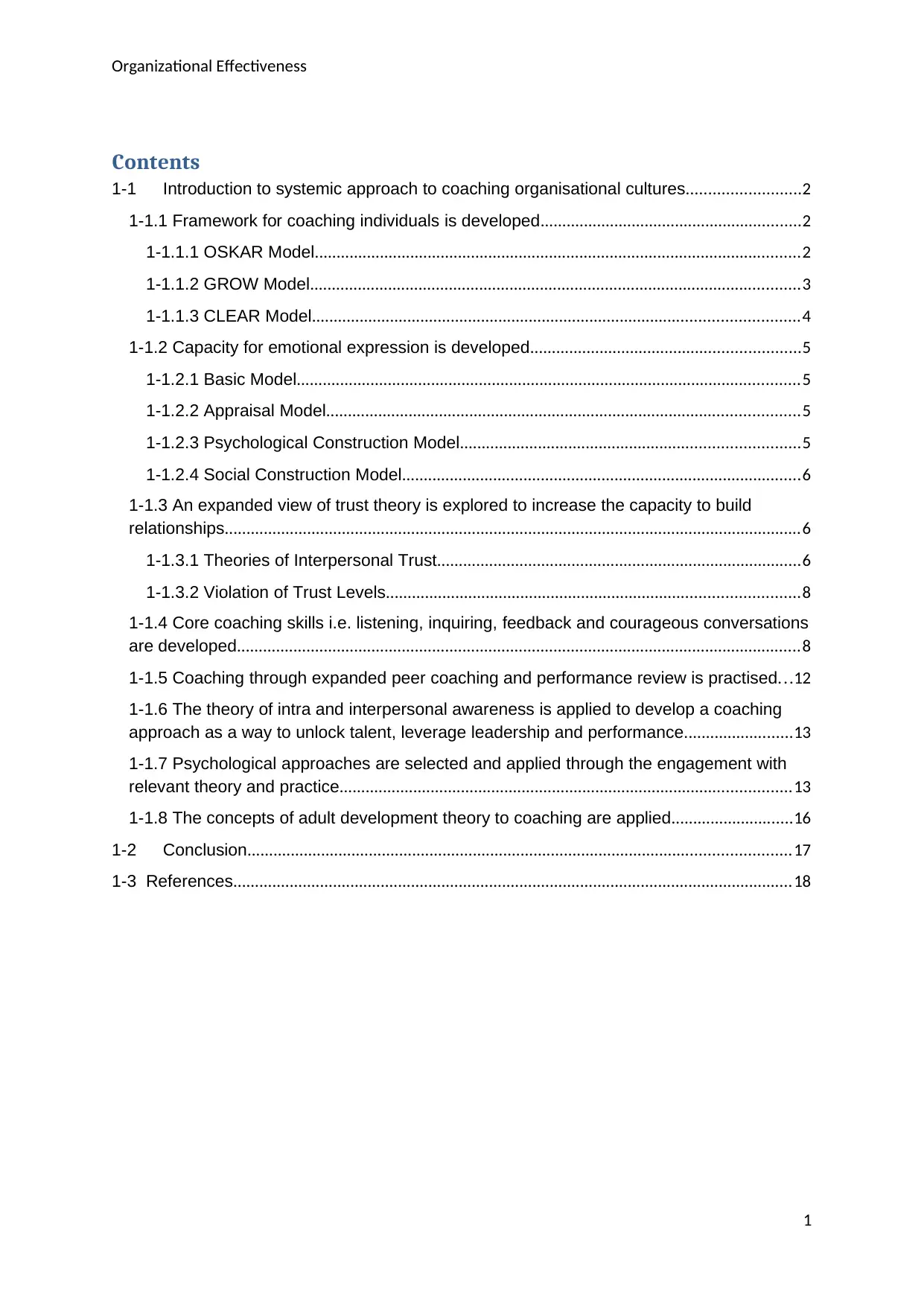
Organizational Effectiveness
Contents
1-1 Introduction to systemic approach to coaching organisational cultures..........................2
1-1.1 Framework for coaching individuals is developed............................................................2
1-1.1.1 OSKAR Model................................................................................................................2
1-1.1.2 GROW Model.................................................................................................................3
1-1.1.3 CLEAR Model................................................................................................................4
1-1.2 Capacity for emotional expression is developed..............................................................5
1-1.2.1 Basic Model....................................................................................................................5
1-1.2.2 Appraisal Model.............................................................................................................5
1-1.2.3 Psychological Construction Model..............................................................................5
1-1.2.4 Social Construction Model............................................................................................6
1-1.3 An expanded view of trust theory is explored to increase the capacity to build
relationships.....................................................................................................................................6
1-1.3.1 Theories of Interpersonal Trust....................................................................................6
1-1.3.2 Violation of Trust Levels...............................................................................................8
1-1.4 Core coaching skills i.e. listening, inquiring, feedback and courageous conversations
are developed..................................................................................................................................8
1-1.5 Coaching through expanded peer coaching and performance review is practised...12
1-1.6 The theory of intra and interpersonal awareness is applied to develop a coaching
approach as a way to unlock talent, leverage leadership and performance.........................13
1-1.7 Psychological approaches are selected and applied through the engagement with
relevant theory and practice........................................................................................................13
1-1.8 The concepts of adult development theory to coaching are applied............................16
1-2 Conclusion.............................................................................................................................17
1-3 References.................................................................................................................................18
1
Contents
1-1 Introduction to systemic approach to coaching organisational cultures..........................2
1-1.1 Framework for coaching individuals is developed............................................................2
1-1.1.1 OSKAR Model................................................................................................................2
1-1.1.2 GROW Model.................................................................................................................3
1-1.1.3 CLEAR Model................................................................................................................4
1-1.2 Capacity for emotional expression is developed..............................................................5
1-1.2.1 Basic Model....................................................................................................................5
1-1.2.2 Appraisal Model.............................................................................................................5
1-1.2.3 Psychological Construction Model..............................................................................5
1-1.2.4 Social Construction Model............................................................................................6
1-1.3 An expanded view of trust theory is explored to increase the capacity to build
relationships.....................................................................................................................................6
1-1.3.1 Theories of Interpersonal Trust....................................................................................6
1-1.3.2 Violation of Trust Levels...............................................................................................8
1-1.4 Core coaching skills i.e. listening, inquiring, feedback and courageous conversations
are developed..................................................................................................................................8
1-1.5 Coaching through expanded peer coaching and performance review is practised...12
1-1.6 The theory of intra and interpersonal awareness is applied to develop a coaching
approach as a way to unlock talent, leverage leadership and performance.........................13
1-1.7 Psychological approaches are selected and applied through the engagement with
relevant theory and practice........................................................................................................13
1-1.8 The concepts of adult development theory to coaching are applied............................16
1-2 Conclusion.............................................................................................................................17
1-3 References.................................................................................................................................18
1
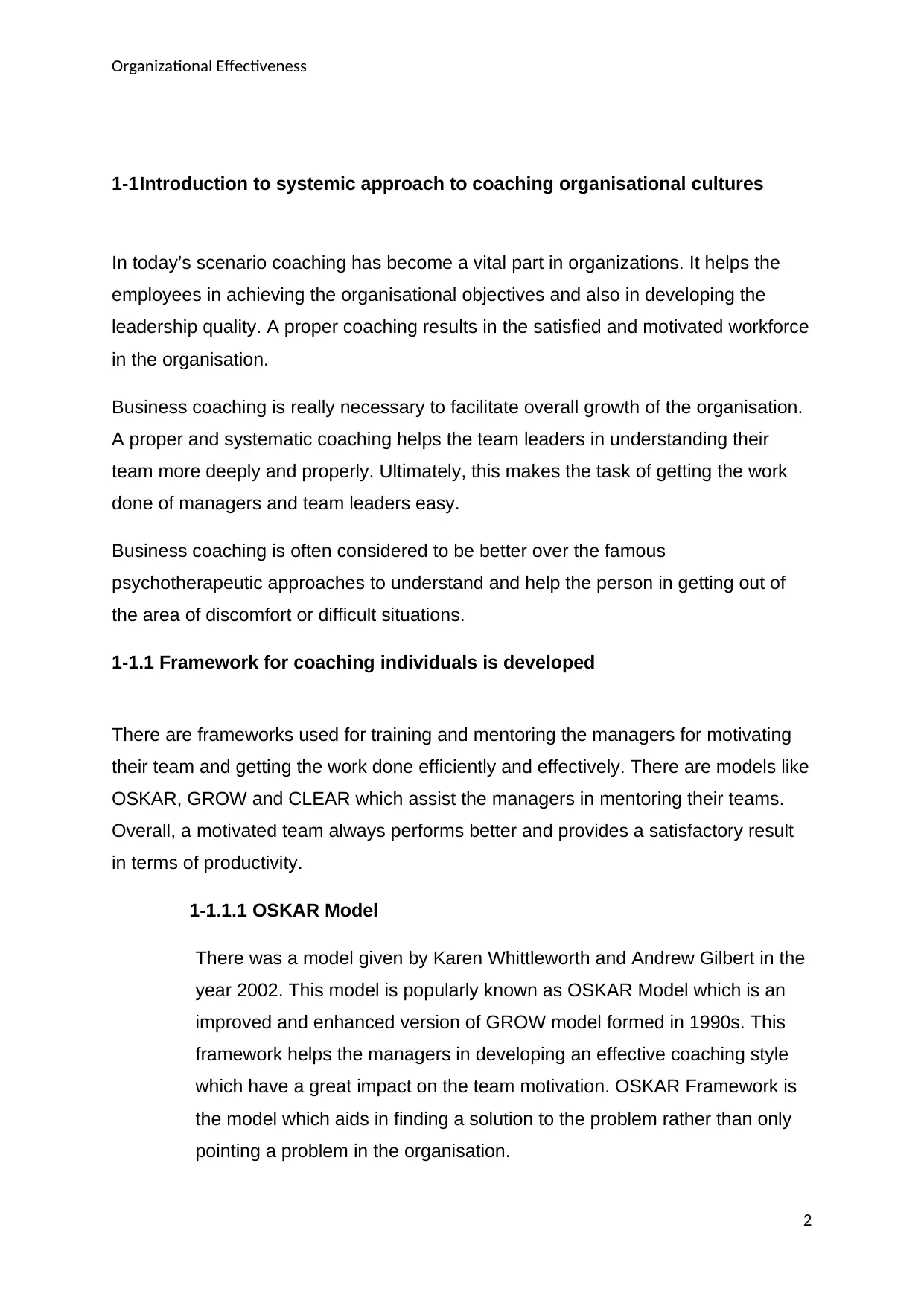
Organizational Effectiveness
1-1Introduction to systemic approach to coaching organisational cultures
In today’s scenario coaching has become a vital part in organizations. It helps the
employees in achieving the organisational objectives and also in developing the
leadership quality. A proper coaching results in the satisfied and motivated workforce
in the organisation.
Business coaching is really necessary to facilitate overall growth of the organisation.
A proper and systematic coaching helps the team leaders in understanding their
team more deeply and properly. Ultimately, this makes the task of getting the work
done of managers and team leaders easy.
Business coaching is often considered to be better over the famous
psychotherapeutic approaches to understand and help the person in getting out of
the area of discomfort or difficult situations.
1-1.1 Framework for coaching individuals is developed
There are frameworks used for training and mentoring the managers for motivating
their team and getting the work done efficiently and effectively. There are models like
OSKAR, GROW and CLEAR which assist the managers in mentoring their teams.
Overall, a motivated team always performs better and provides a satisfactory result
in terms of productivity.
1-1.1.1 OSKAR Model
There was a model given by Karen Whittleworth and Andrew Gilbert in the
year 2002. This model is popularly known as OSKAR Model which is an
improved and enhanced version of GROW model formed in 1990s. This
framework helps the managers in developing an effective coaching style
which have a great impact on the team motivation. OSKAR Framework is
the model which aids in finding a solution to the problem rather than only
pointing a problem in the organisation.
2
1-1Introduction to systemic approach to coaching organisational cultures
In today’s scenario coaching has become a vital part in organizations. It helps the
employees in achieving the organisational objectives and also in developing the
leadership quality. A proper coaching results in the satisfied and motivated workforce
in the organisation.
Business coaching is really necessary to facilitate overall growth of the organisation.
A proper and systematic coaching helps the team leaders in understanding their
team more deeply and properly. Ultimately, this makes the task of getting the work
done of managers and team leaders easy.
Business coaching is often considered to be better over the famous
psychotherapeutic approaches to understand and help the person in getting out of
the area of discomfort or difficult situations.
1-1.1 Framework for coaching individuals is developed
There are frameworks used for training and mentoring the managers for motivating
their team and getting the work done efficiently and effectively. There are models like
OSKAR, GROW and CLEAR which assist the managers in mentoring their teams.
Overall, a motivated team always performs better and provides a satisfactory result
in terms of productivity.
1-1.1.1 OSKAR Model
There was a model given by Karen Whittleworth and Andrew Gilbert in the
year 2002. This model is popularly known as OSKAR Model which is an
improved and enhanced version of GROW model formed in 1990s. This
framework helps the managers in developing an effective coaching style
which have a great impact on the team motivation. OSKAR Framework is
the model which aids in finding a solution to the problem rather than only
pointing a problem in the organisation.
2
⊘ This is a preview!⊘
Do you want full access?
Subscribe today to unlock all pages.

Trusted by 1+ million students worldwide
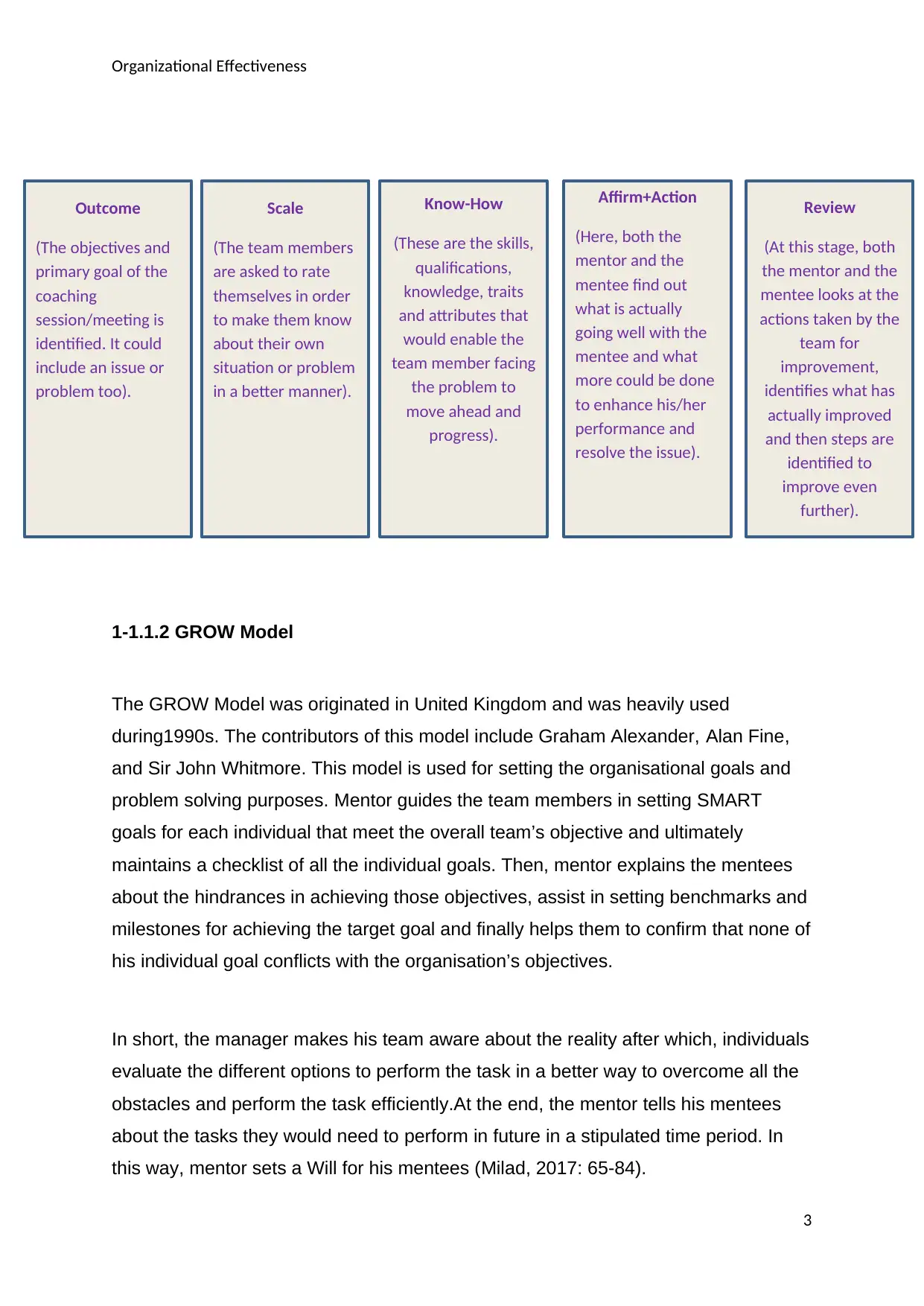
Organizational Effectiveness
1-1.1.2 GROW Model
The GROW Model was originated in United Kingdom and was heavily used
during1990s. The contributors of this model include Graham Alexander, Alan Fine,
and Sir John Whitmore. This model is used for setting the organisational goals and
problem solving purposes. Mentor guides the team members in setting SMART
goals for each individual that meet the overall team’s objective and ultimately
maintains a checklist of all the individual goals. Then, mentor explains the mentees
about the hindrances in achieving those objectives, assist in setting benchmarks and
milestones for achieving the target goal and finally helps them to confirm that none of
his individual goal conflicts with the organisation’s objectives.
In short, the manager makes his team aware about the reality after which, individuals
evaluate the different options to perform the task in a better way to overcome all the
obstacles and perform the task efficiently.At the end, the mentor tells his mentees
about the tasks they would need to perform in future in a stipulated time period. In
this way, mentor sets a Will for his mentees (Milad, 2017: 65-84).
3
Outcome
(The objectives and
primary goal of the
coaching
session/meeting is
identified. It could
include an issue or
problem too).
Scale
(The team members
are asked to rate
themselves in order
to make them know
about their own
situation or problem
in a better manner).
Know-How
(These are the skills,
qualifications,
knowledge, traits
and attributes that
would enable the
team member facing
the problem to
move ahead and
progress).
Affirm+Action
(Here, both the
mentor and the
mentee find out
what is actually
going well with the
mentee and what
more could be done
to enhance his/her
performance and
resolve the issue).
Review
(At this stage, both
the mentor and the
mentee looks at the
actions taken by the
team for
improvement,
identifies what has
actually improved
and then steps are
identified to
improve even
further).
1-1.1.2 GROW Model
The GROW Model was originated in United Kingdom and was heavily used
during1990s. The contributors of this model include Graham Alexander, Alan Fine,
and Sir John Whitmore. This model is used for setting the organisational goals and
problem solving purposes. Mentor guides the team members in setting SMART
goals for each individual that meet the overall team’s objective and ultimately
maintains a checklist of all the individual goals. Then, mentor explains the mentees
about the hindrances in achieving those objectives, assist in setting benchmarks and
milestones for achieving the target goal and finally helps them to confirm that none of
his individual goal conflicts with the organisation’s objectives.
In short, the manager makes his team aware about the reality after which, individuals
evaluate the different options to perform the task in a better way to overcome all the
obstacles and perform the task efficiently.At the end, the mentor tells his mentees
about the tasks they would need to perform in future in a stipulated time period. In
this way, mentor sets a Will for his mentees (Milad, 2017: 65-84).
3
Outcome
(The objectives and
primary goal of the
coaching
session/meeting is
identified. It could
include an issue or
problem too).
Scale
(The team members
are asked to rate
themselves in order
to make them know
about their own
situation or problem
in a better manner).
Know-How
(These are the skills,
qualifications,
knowledge, traits
and attributes that
would enable the
team member facing
the problem to
move ahead and
progress).
Affirm+Action
(Here, both the
mentor and the
mentee find out
what is actually
going well with the
mentee and what
more could be done
to enhance his/her
performance and
resolve the issue).
Review
(At this stage, both
the mentor and the
mentee looks at the
actions taken by the
team for
improvement,
identifies what has
actually improved
and then steps are
identified to
improve even
further).
Paraphrase This Document
Need a fresh take? Get an instant paraphrase of this document with our AI Paraphraser
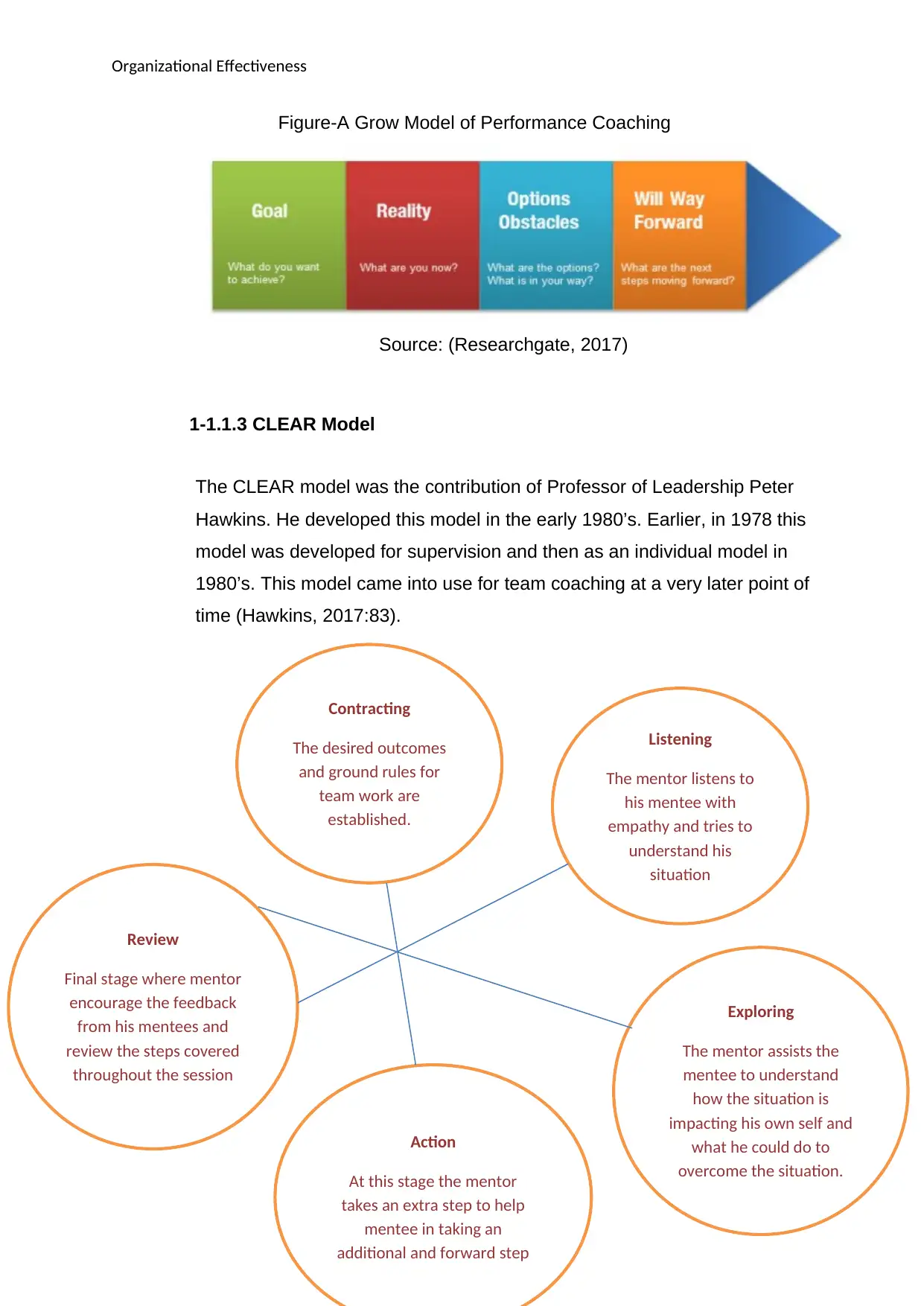
Organizational Effectiveness
Figure-A Grow Model of Performance Coaching
Source: (Researchgate, 2017)
1-1.1.3 CLEAR Model
The CLEAR model was the contribution of Professor of Leadership Peter
Hawkins. He developed this model in the early 1980’s. Earlier, in 1978 this
model was developed for supervision and then as an individual model in
1980’s. This model came into use for team coaching at a very later point of
time (Hawkins, 2017:83).
4
Contracting
The desired outcomes
and ground rules for
team work are
established.
Action
At this stage the mentor
takes an extra step to help
mentee in taking an
additional and forward step
Review
Final stage where mentor
encourage the feedback
from his mentees and
review the steps covered
throughout the session
Exploring
The mentor assists the
mentee to understand
how the situation is
impacting his own self and
what he could do to
overcome the situation.
Listening
The mentor listens to
his mentee with
empathy and tries to
understand his
situation
Figure-A Grow Model of Performance Coaching
Source: (Researchgate, 2017)
1-1.1.3 CLEAR Model
The CLEAR model was the contribution of Professor of Leadership Peter
Hawkins. He developed this model in the early 1980’s. Earlier, in 1978 this
model was developed for supervision and then as an individual model in
1980’s. This model came into use for team coaching at a very later point of
time (Hawkins, 2017:83).
4
Contracting
The desired outcomes
and ground rules for
team work are
established.
Action
At this stage the mentor
takes an extra step to help
mentee in taking an
additional and forward step
Review
Final stage where mentor
encourage the feedback
from his mentees and
review the steps covered
throughout the session
Exploring
The mentor assists the
mentee to understand
how the situation is
impacting his own self and
what he could do to
overcome the situation.
Listening
The mentor listens to
his mentee with
empathy and tries to
understand his
situation
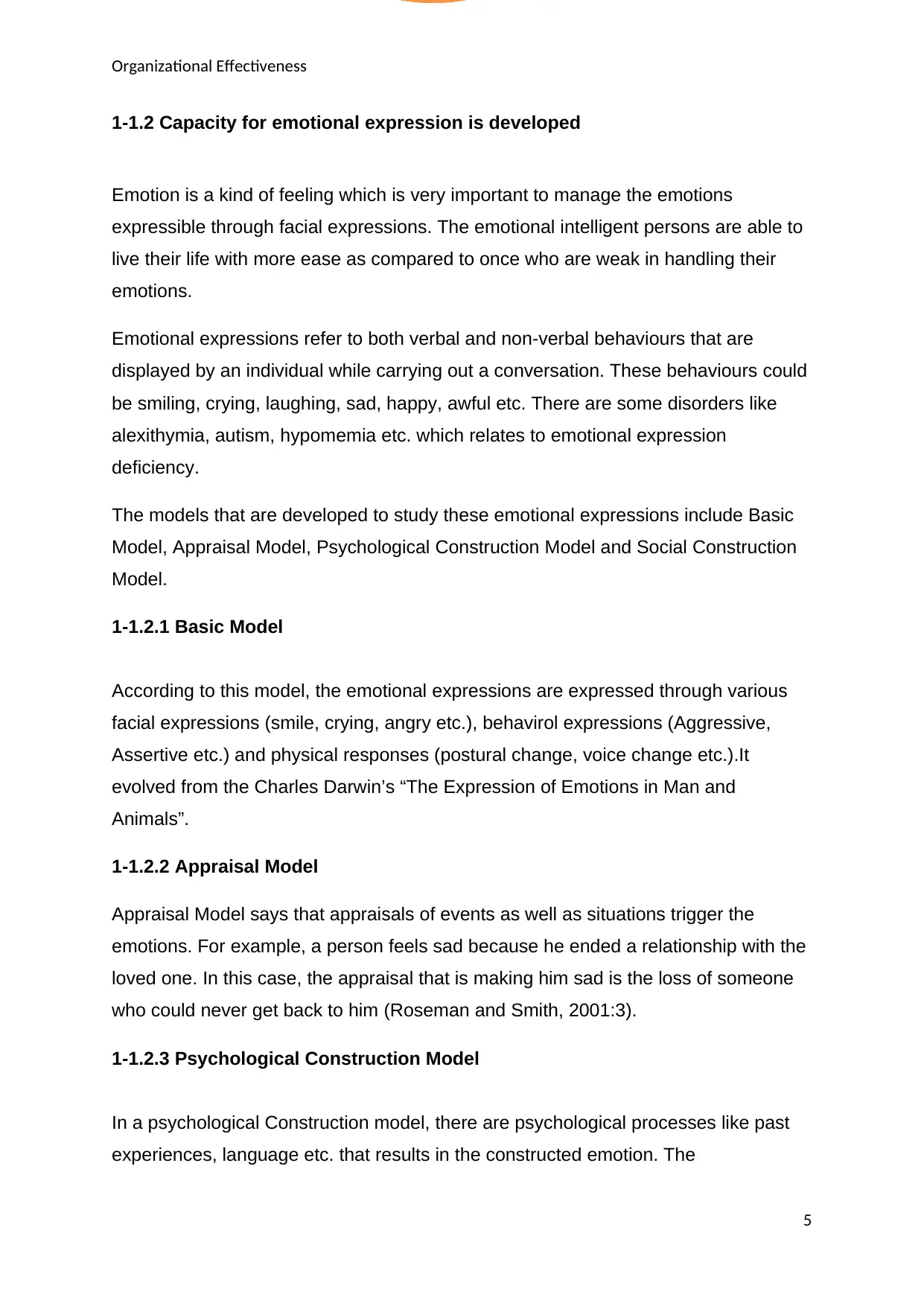
Organizational Effectiveness
1-1.2 Capacity for emotional expression is developed
Emotion is a kind of feeling which is very important to manage the emotions
expressible through facial expressions. The emotional intelligent persons are able to
live their life with more ease as compared to once who are weak in handling their
emotions.
Emotional expressions refer to both verbal and non-verbal behaviours that are
displayed by an individual while carrying out a conversation. These behaviours could
be smiling, crying, laughing, sad, happy, awful etc. There are some disorders like
alexithymia, autism, hypomemia etc. which relates to emotional expression
deficiency.
The models that are developed to study these emotional expressions include Basic
Model, Appraisal Model, Psychological Construction Model and Social Construction
Model.
1-1.2.1 Basic Model
According to this model, the emotional expressions are expressed through various
facial expressions (smile, crying, angry etc.), behavirol expressions (Aggressive,
Assertive etc.) and physical responses (postural change, voice change etc.).It
evolved from the Charles Darwin’s “The Expression of Emotions in Man and
Animals”.
1-1.2.2 Appraisal Model
Appraisal Model says that appraisals of events as well as situations trigger the
emotions. For example, a person feels sad because he ended a relationship with the
loved one. In this case, the appraisal that is making him sad is the loss of someone
who could never get back to him (Roseman and Smith, 2001:3).
1-1.2.3 Psychological Construction Model
In a psychological Construction model, there are psychological processes like past
experiences, language etc. that results in the constructed emotion. The
5
1-1.2 Capacity for emotional expression is developed
Emotion is a kind of feeling which is very important to manage the emotions
expressible through facial expressions. The emotional intelligent persons are able to
live their life with more ease as compared to once who are weak in handling their
emotions.
Emotional expressions refer to both verbal and non-verbal behaviours that are
displayed by an individual while carrying out a conversation. These behaviours could
be smiling, crying, laughing, sad, happy, awful etc. There are some disorders like
alexithymia, autism, hypomemia etc. which relates to emotional expression
deficiency.
The models that are developed to study these emotional expressions include Basic
Model, Appraisal Model, Psychological Construction Model and Social Construction
Model.
1-1.2.1 Basic Model
According to this model, the emotional expressions are expressed through various
facial expressions (smile, crying, angry etc.), behavirol expressions (Aggressive,
Assertive etc.) and physical responses (postural change, voice change etc.).It
evolved from the Charles Darwin’s “The Expression of Emotions in Man and
Animals”.
1-1.2.2 Appraisal Model
Appraisal Model says that appraisals of events as well as situations trigger the
emotions. For example, a person feels sad because he ended a relationship with the
loved one. In this case, the appraisal that is making him sad is the loss of someone
who could never get back to him (Roseman and Smith, 2001:3).
1-1.2.3 Psychological Construction Model
In a psychological Construction model, there are psychological processes like past
experiences, language etc. that results in the constructed emotion. The
5
⊘ This is a preview!⊘
Do you want full access?
Subscribe today to unlock all pages.

Trusted by 1+ million students worldwide
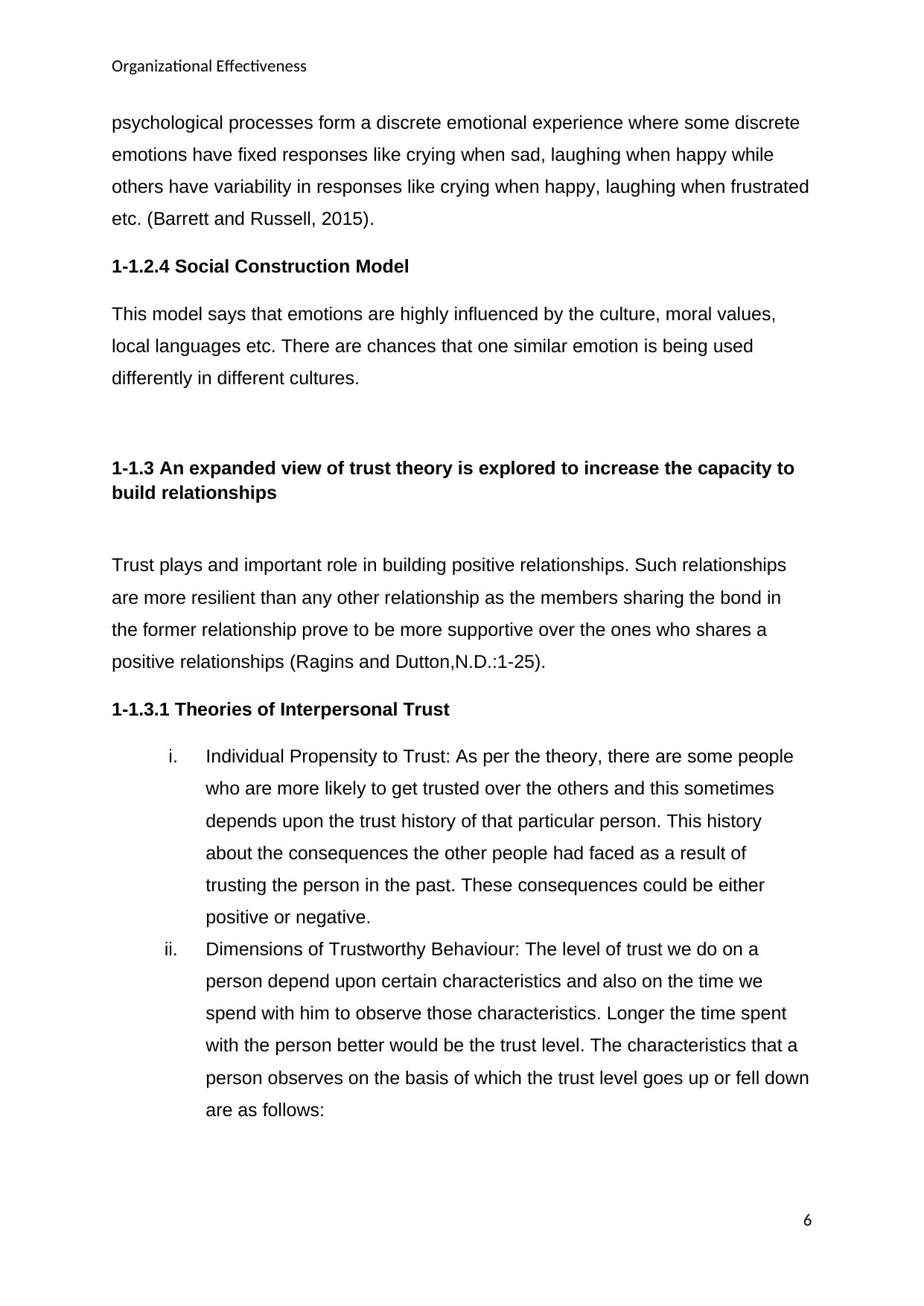
Organizational Effectiveness
psychological processes form a discrete emotional experience where some discrete
emotions have fixed responses like crying when sad, laughing when happy while
others have variability in responses like crying when happy, laughing when frustrated
etc. (Barrett and Russell, 2015).
1-1.2.4 Social Construction Model
This model says that emotions are highly influenced by the culture, moral values,
local languages etc. There are chances that one similar emotion is being used
differently in different cultures.
1-1.3 An expanded view of trust theory is explored to increase the capacity to
build relationships
Trust plays and important role in building positive relationships. Such relationships
are more resilient than any other relationship as the members sharing the bond in
the former relationship prove to be more supportive over the ones who shares a
positive relationships (Ragins and Dutton,N.D.:1-25).
1-1.3.1 Theories of Interpersonal Trust
i. Individual Propensity to Trust: As per the theory, there are some people
who are more likely to get trusted over the others and this sometimes
depends upon the trust history of that particular person. This history
about the consequences the other people had faced as a result of
trusting the person in the past. These consequences could be either
positive or negative.
ii. Dimensions of Trustworthy Behaviour: The level of trust we do on a
person depend upon certain characteristics and also on the time we
spend with him to observe those characteristics. Longer the time spent
with the person better would be the trust level. The characteristics that a
person observes on the basis of which the trust level goes up or fell down
are as follows:
6
psychological processes form a discrete emotional experience where some discrete
emotions have fixed responses like crying when sad, laughing when happy while
others have variability in responses like crying when happy, laughing when frustrated
etc. (Barrett and Russell, 2015).
1-1.2.4 Social Construction Model
This model says that emotions are highly influenced by the culture, moral values,
local languages etc. There are chances that one similar emotion is being used
differently in different cultures.
1-1.3 An expanded view of trust theory is explored to increase the capacity to
build relationships
Trust plays and important role in building positive relationships. Such relationships
are more resilient than any other relationship as the members sharing the bond in
the former relationship prove to be more supportive over the ones who shares a
positive relationships (Ragins and Dutton,N.D.:1-25).
1-1.3.1 Theories of Interpersonal Trust
i. Individual Propensity to Trust: As per the theory, there are some people
who are more likely to get trusted over the others and this sometimes
depends upon the trust history of that particular person. This history
about the consequences the other people had faced as a result of
trusting the person in the past. These consequences could be either
positive or negative.
ii. Dimensions of Trustworthy Behaviour: The level of trust we do on a
person depend upon certain characteristics and also on the time we
spend with him to observe those characteristics. Longer the time spent
with the person better would be the trust level. The characteristics that a
person observes on the basis of which the trust level goes up or fell down
are as follows:
6
Paraphrase This Document
Need a fresh take? Get an instant paraphrase of this document with our AI Paraphraser
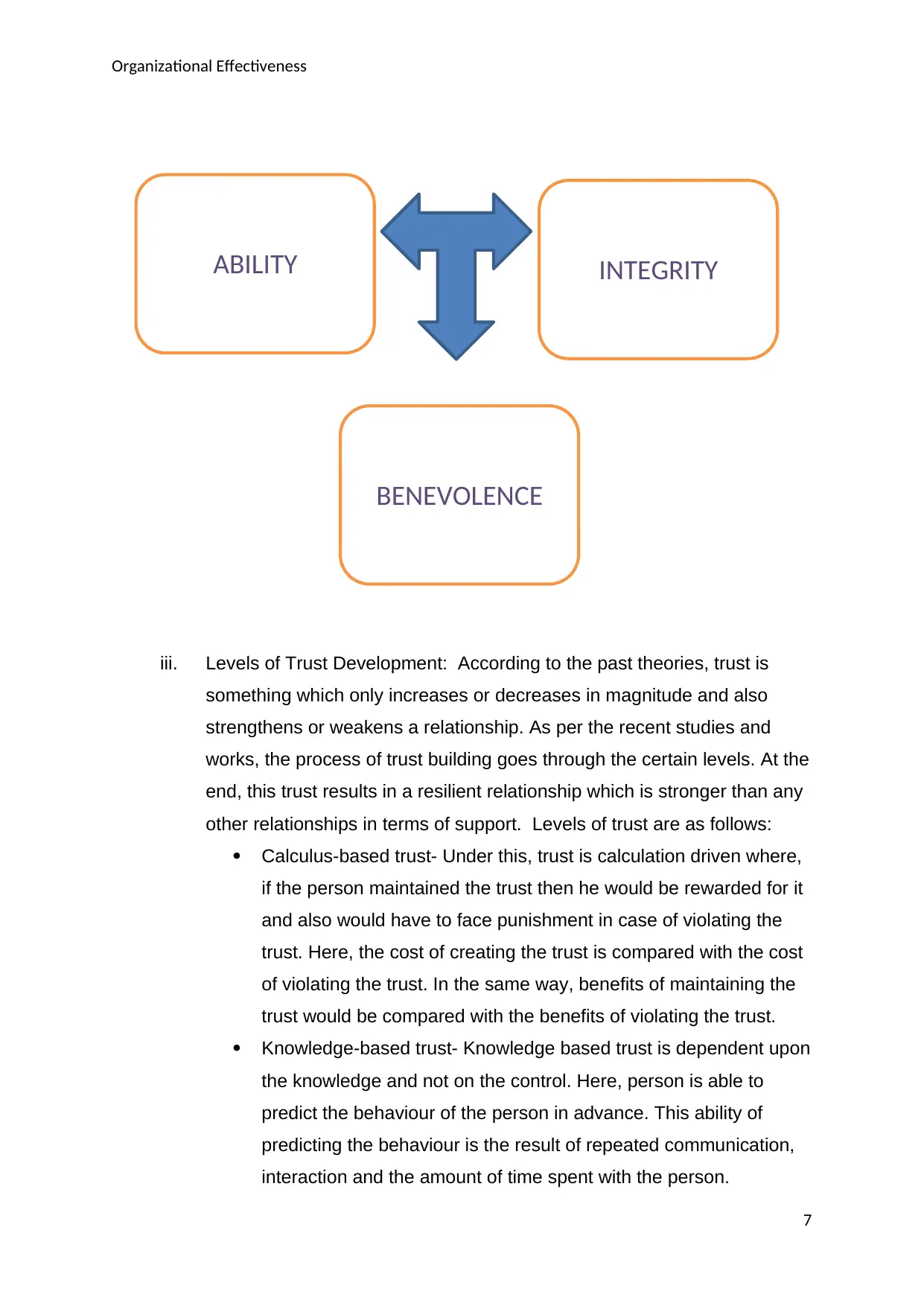
Organizational Effectiveness
iii. Levels of Trust Development: According to the past theories, trust is
something which only increases or decreases in magnitude and also
strengthens or weakens a relationship. As per the recent studies and
works, the process of trust building goes through the certain levels. At the
end, this trust results in a resilient relationship which is stronger than any
other relationships in terms of support. Levels of trust are as follows:
Calculus-based trust- Under this, trust is calculation driven where,
if the person maintained the trust then he would be rewarded for it
and also would have to face punishment in case of violating the
trust. Here, the cost of creating the trust is compared with the cost
of violating the trust. In the same way, benefits of maintaining the
trust would be compared with the benefits of violating the trust.
Knowledge-based trust- Knowledge based trust is dependent upon
the knowledge and not on the control. Here, person is able to
predict the behaviour of the person in advance. This ability of
predicting the behaviour is the result of repeated communication,
interaction and the amount of time spent with the person.
7
ABILITY
BENEVOLENCE
INTEGRITY
iii. Levels of Trust Development: According to the past theories, trust is
something which only increases or decreases in magnitude and also
strengthens or weakens a relationship. As per the recent studies and
works, the process of trust building goes through the certain levels. At the
end, this trust results in a resilient relationship which is stronger than any
other relationships in terms of support. Levels of trust are as follows:
Calculus-based trust- Under this, trust is calculation driven where,
if the person maintained the trust then he would be rewarded for it
and also would have to face punishment in case of violating the
trust. Here, the cost of creating the trust is compared with the cost
of violating the trust. In the same way, benefits of maintaining the
trust would be compared with the benefits of violating the trust.
Knowledge-based trust- Knowledge based trust is dependent upon
the knowledge and not on the control. Here, person is able to
predict the behaviour of the person in advance. This ability of
predicting the behaviour is the result of repeated communication,
interaction and the amount of time spent with the person.
7
ABILITY
BENEVOLENCE
INTEGRITY
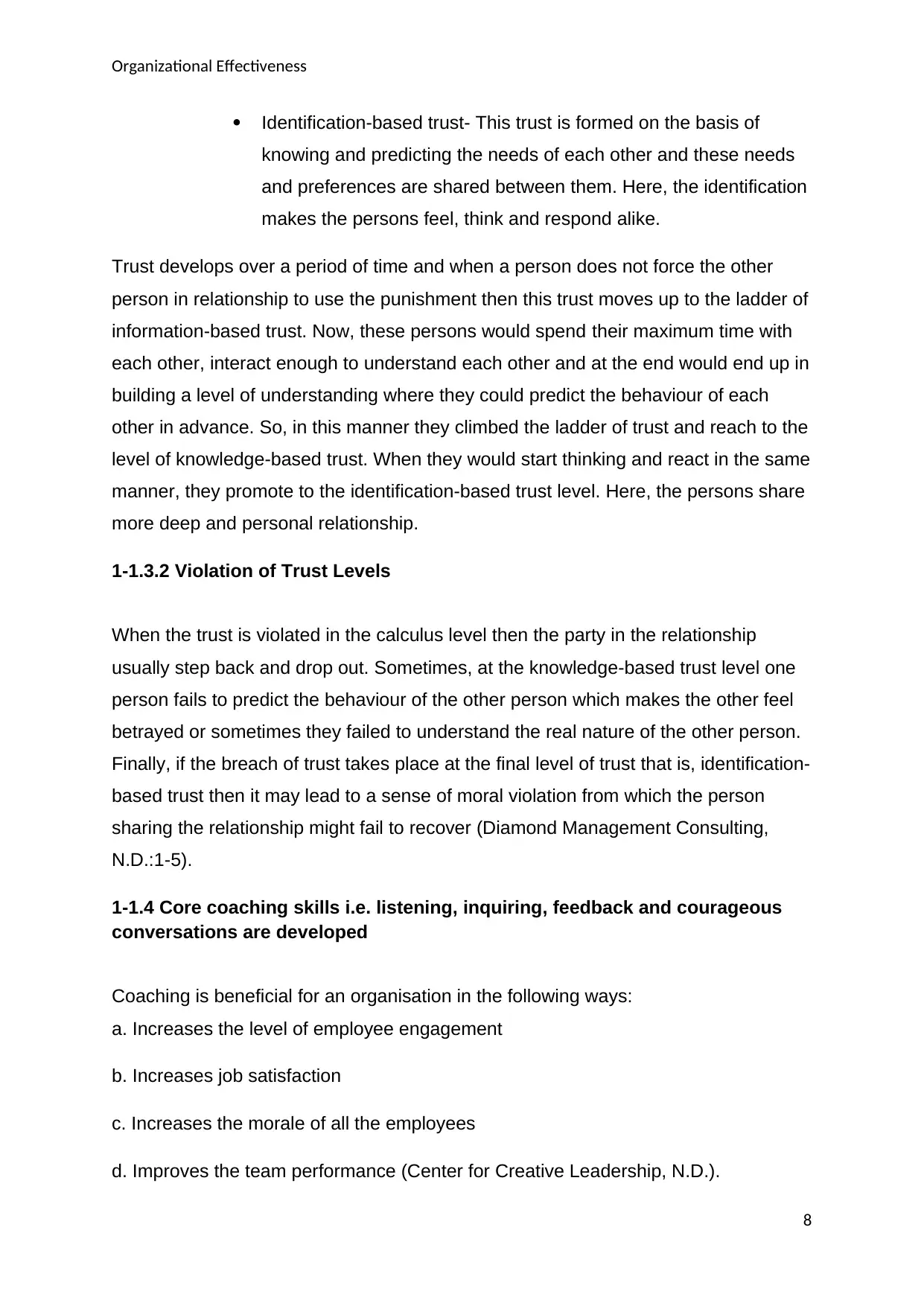
Organizational Effectiveness
Identification-based trust- This trust is formed on the basis of
knowing and predicting the needs of each other and these needs
and preferences are shared between them. Here, the identification
makes the persons feel, think and respond alike.
Trust develops over a period of time and when a person does not force the other
person in relationship to use the punishment then this trust moves up to the ladder of
information-based trust. Now, these persons would spend their maximum time with
each other, interact enough to understand each other and at the end would end up in
building a level of understanding where they could predict the behaviour of each
other in advance. So, in this manner they climbed the ladder of trust and reach to the
level of knowledge-based trust. When they would start thinking and react in the same
manner, they promote to the identification-based trust level. Here, the persons share
more deep and personal relationship.
1-1.3.2 Violation of Trust Levels
When the trust is violated in the calculus level then the party in the relationship
usually step back and drop out. Sometimes, at the knowledge-based trust level one
person fails to predict the behaviour of the other person which makes the other feel
betrayed or sometimes they failed to understand the real nature of the other person.
Finally, if the breach of trust takes place at the final level of trust that is, identification-
based trust then it may lead to a sense of moral violation from which the person
sharing the relationship might fail to recover (Diamond Management Consulting,
N.D.:1-5).
1-1.4 Core coaching skills i.e. listening, inquiring, feedback and courageous
conversations are developed
Coaching is beneficial for an organisation in the following ways:
a. Increases the level of employee engagement
b. Increases job satisfaction
c. Increases the morale of all the employees
d. Improves the team performance (Center for Creative Leadership, N.D.).
8
Identification-based trust- This trust is formed on the basis of
knowing and predicting the needs of each other and these needs
and preferences are shared between them. Here, the identification
makes the persons feel, think and respond alike.
Trust develops over a period of time and when a person does not force the other
person in relationship to use the punishment then this trust moves up to the ladder of
information-based trust. Now, these persons would spend their maximum time with
each other, interact enough to understand each other and at the end would end up in
building a level of understanding where they could predict the behaviour of each
other in advance. So, in this manner they climbed the ladder of trust and reach to the
level of knowledge-based trust. When they would start thinking and react in the same
manner, they promote to the identification-based trust level. Here, the persons share
more deep and personal relationship.
1-1.3.2 Violation of Trust Levels
When the trust is violated in the calculus level then the party in the relationship
usually step back and drop out. Sometimes, at the knowledge-based trust level one
person fails to predict the behaviour of the other person which makes the other feel
betrayed or sometimes they failed to understand the real nature of the other person.
Finally, if the breach of trust takes place at the final level of trust that is, identification-
based trust then it may lead to a sense of moral violation from which the person
sharing the relationship might fail to recover (Diamond Management Consulting,
N.D.:1-5).
1-1.4 Core coaching skills i.e. listening, inquiring, feedback and courageous
conversations are developed
Coaching is beneficial for an organisation in the following ways:
a. Increases the level of employee engagement
b. Increases job satisfaction
c. Increases the morale of all the employees
d. Improves the team performance (Center for Creative Leadership, N.D.).
8
⊘ This is a preview!⊘
Do you want full access?
Subscribe today to unlock all pages.

Trusted by 1+ million students worldwide
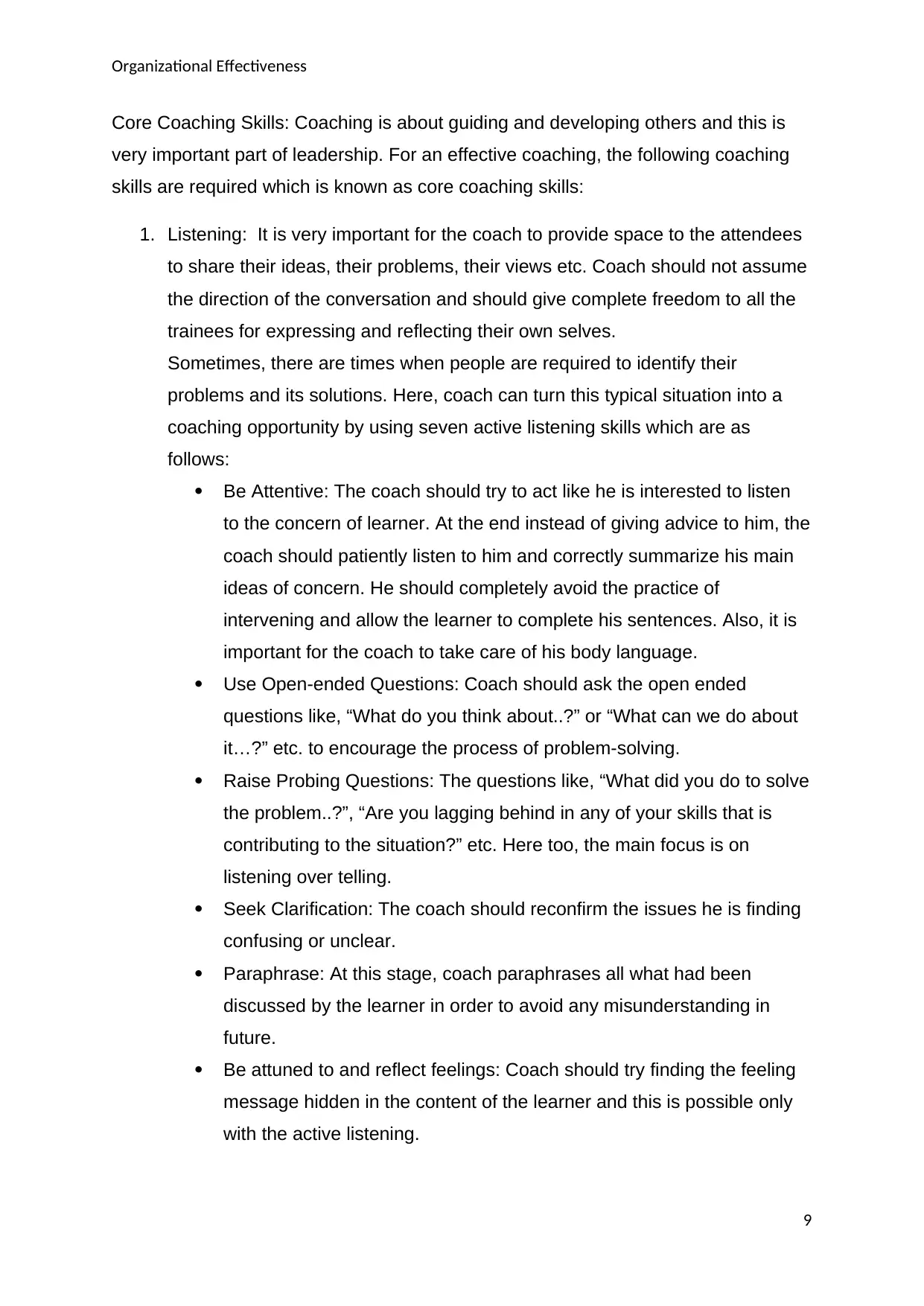
Organizational Effectiveness
Core Coaching Skills: Coaching is about guiding and developing others and this is
very important part of leadership. For an effective coaching, the following coaching
skills are required which is known as core coaching skills:
1. Listening: It is very important for the coach to provide space to the attendees
to share their ideas, their problems, their views etc. Coach should not assume
the direction of the conversation and should give complete freedom to all the
trainees for expressing and reflecting their own selves.
Sometimes, there are times when people are required to identify their
problems and its solutions. Here, coach can turn this typical situation into a
coaching opportunity by using seven active listening skills which are as
follows:
Be Attentive: The coach should try to act like he is interested to listen
to the concern of learner. At the end instead of giving advice to him, the
coach should patiently listen to him and correctly summarize his main
ideas of concern. He should completely avoid the practice of
intervening and allow the learner to complete his sentences. Also, it is
important for the coach to take care of his body language.
Use Open-ended Questions: Coach should ask the open ended
questions like, “What do you think about..?” or “What can we do about
it…?” etc. to encourage the process of problem-solving.
Raise Probing Questions: The questions like, “What did you do to solve
the problem..?”, “Are you lagging behind in any of your skills that is
contributing to the situation?” etc. Here too, the main focus is on
listening over telling.
Seek Clarification: The coach should reconfirm the issues he is finding
confusing or unclear.
Paraphrase: At this stage, coach paraphrases all what had been
discussed by the learner in order to avoid any misunderstanding in
future.
Be attuned to and reflect feelings: Coach should try finding the feeling
message hidden in the content of the learner and this is possible only
with the active listening.
9
Core Coaching Skills: Coaching is about guiding and developing others and this is
very important part of leadership. For an effective coaching, the following coaching
skills are required which is known as core coaching skills:
1. Listening: It is very important for the coach to provide space to the attendees
to share their ideas, their problems, their views etc. Coach should not assume
the direction of the conversation and should give complete freedom to all the
trainees for expressing and reflecting their own selves.
Sometimes, there are times when people are required to identify their
problems and its solutions. Here, coach can turn this typical situation into a
coaching opportunity by using seven active listening skills which are as
follows:
Be Attentive: The coach should try to act like he is interested to listen
to the concern of learner. At the end instead of giving advice to him, the
coach should patiently listen to him and correctly summarize his main
ideas of concern. He should completely avoid the practice of
intervening and allow the learner to complete his sentences. Also, it is
important for the coach to take care of his body language.
Use Open-ended Questions: Coach should ask the open ended
questions like, “What do you think about..?” or “What can we do about
it…?” etc. to encourage the process of problem-solving.
Raise Probing Questions: The questions like, “What did you do to solve
the problem..?”, “Are you lagging behind in any of your skills that is
contributing to the situation?” etc. Here too, the main focus is on
listening over telling.
Seek Clarification: The coach should reconfirm the issues he is finding
confusing or unclear.
Paraphrase: At this stage, coach paraphrases all what had been
discussed by the learner in order to avoid any misunderstanding in
future.
Be attuned to and reflect feelings: Coach should try finding the feeling
message hidden in the content of the learner and this is possible only
with the active listening.
9
Paraphrase This Document
Need a fresh take? Get an instant paraphrase of this document with our AI Paraphraser
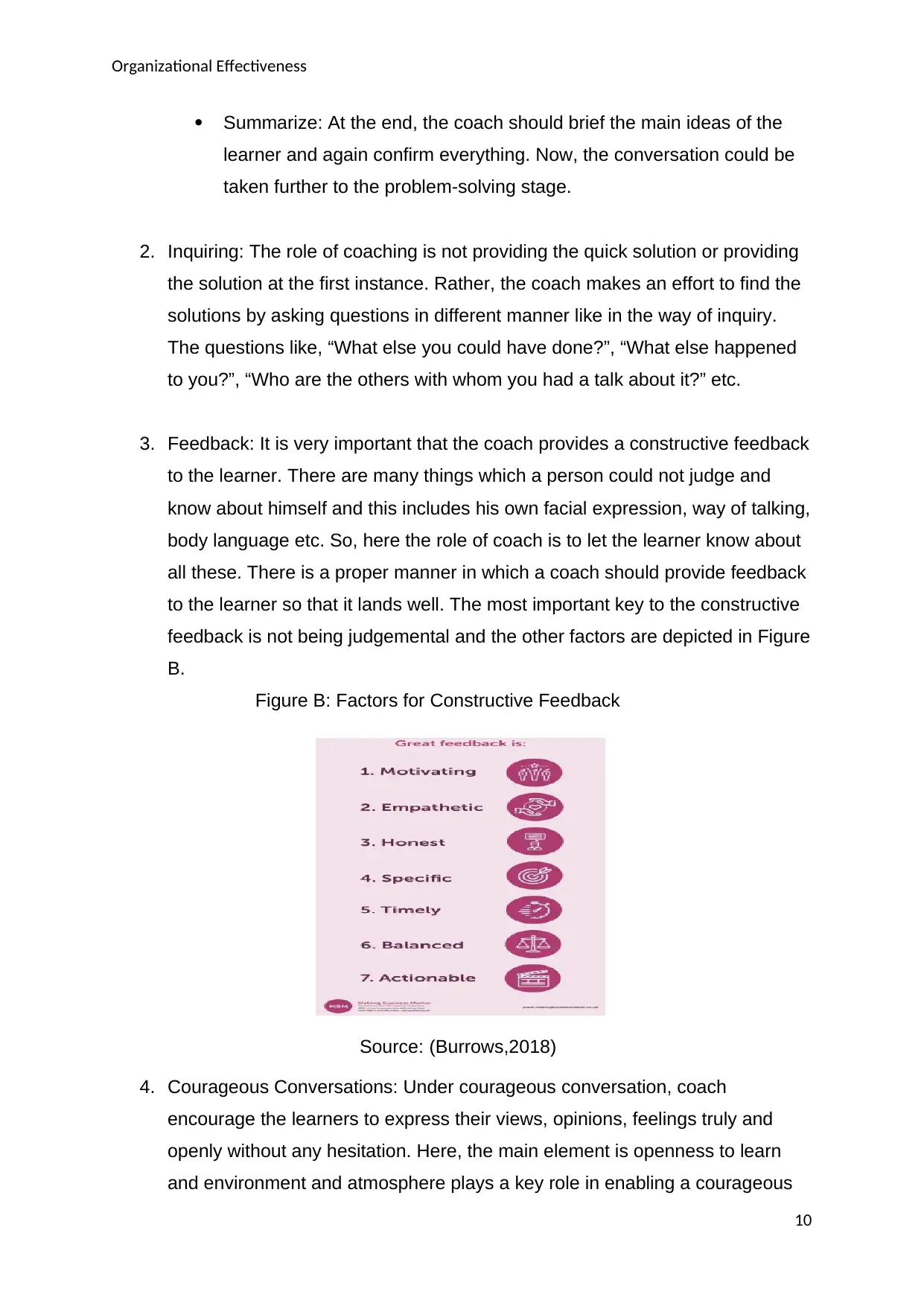
Organizational Effectiveness
Summarize: At the end, the coach should brief the main ideas of the
learner and again confirm everything. Now, the conversation could be
taken further to the problem-solving stage.
2. Inquiring: The role of coaching is not providing the quick solution or providing
the solution at the first instance. Rather, the coach makes an effort to find the
solutions by asking questions in different manner like in the way of inquiry.
The questions like, “What else you could have done?”, “What else happened
to you?”, “Who are the others with whom you had a talk about it?” etc.
3. Feedback: It is very important that the coach provides a constructive feedback
to the learner. There are many things which a person could not judge and
know about himself and this includes his own facial expression, way of talking,
body language etc. So, here the role of coach is to let the learner know about
all these. There is a proper manner in which a coach should provide feedback
to the learner so that it lands well. The most important key to the constructive
feedback is not being judgemental and the other factors are depicted in Figure
B.
Figure B: Factors for Constructive Feedback
Source: (Burrows,2018)
4. Courageous Conversations: Under courageous conversation, coach
encourage the learners to express their views, opinions, feelings truly and
openly without any hesitation. Here, the main element is openness to learn
and environment and atmosphere plays a key role in enabling a courageous
10
Summarize: At the end, the coach should brief the main ideas of the
learner and again confirm everything. Now, the conversation could be
taken further to the problem-solving stage.
2. Inquiring: The role of coaching is not providing the quick solution or providing
the solution at the first instance. Rather, the coach makes an effort to find the
solutions by asking questions in different manner like in the way of inquiry.
The questions like, “What else you could have done?”, “What else happened
to you?”, “Who are the others with whom you had a talk about it?” etc.
3. Feedback: It is very important that the coach provides a constructive feedback
to the learner. There are many things which a person could not judge and
know about himself and this includes his own facial expression, way of talking,
body language etc. So, here the role of coach is to let the learner know about
all these. There is a proper manner in which a coach should provide feedback
to the learner so that it lands well. The most important key to the constructive
feedback is not being judgemental and the other factors are depicted in Figure
B.
Figure B: Factors for Constructive Feedback
Source: (Burrows,2018)
4. Courageous Conversations: Under courageous conversation, coach
encourage the learners to express their views, opinions, feelings truly and
openly without any hesitation. Here, the main element is openness to learn
and environment and atmosphere plays a key role in enabling a courageous
10
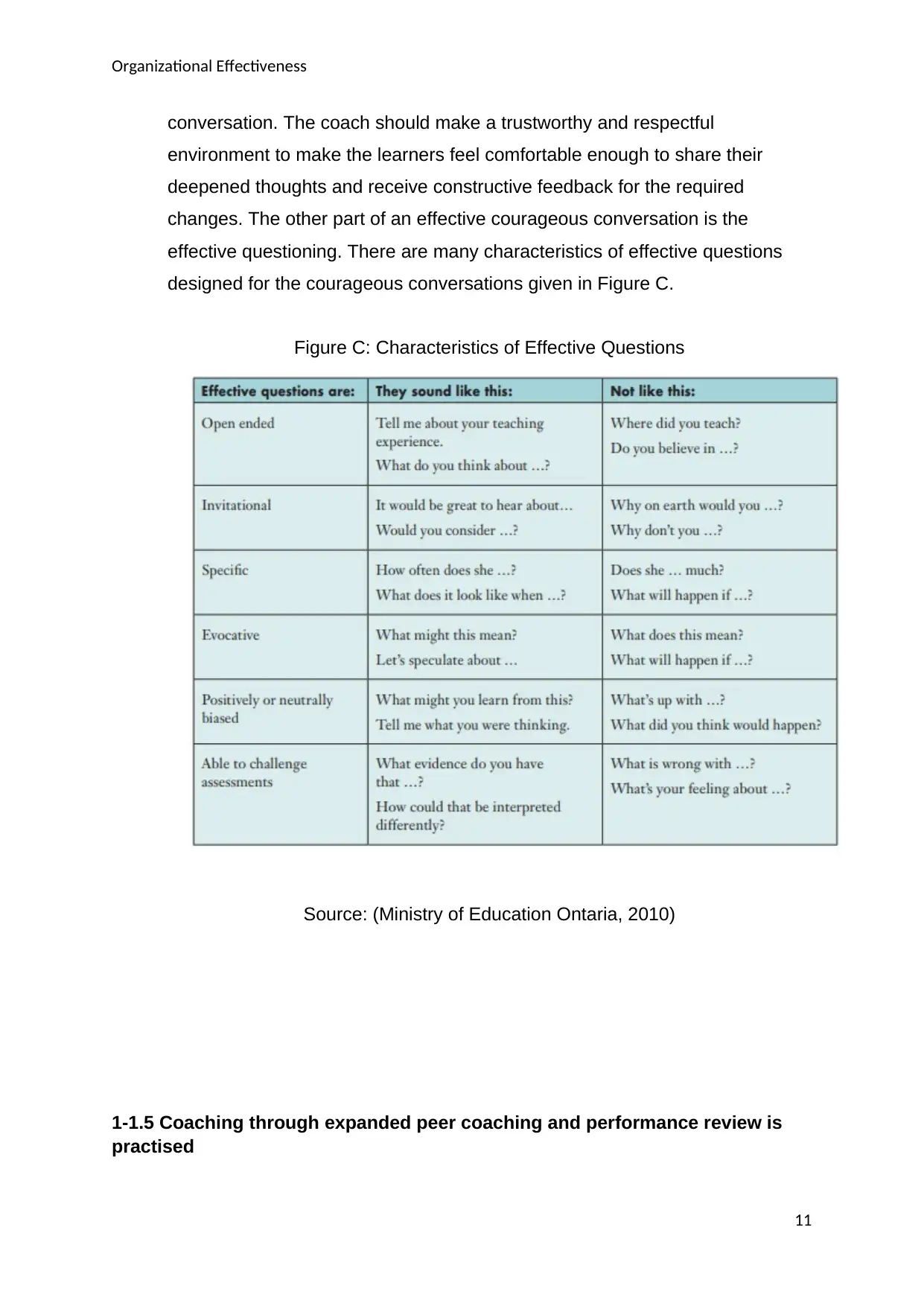
Organizational Effectiveness
conversation. The coach should make a trustworthy and respectful
environment to make the learners feel comfortable enough to share their
deepened thoughts and receive constructive feedback for the required
changes. The other part of an effective courageous conversation is the
effective questioning. There are many characteristics of effective questions
designed for the courageous conversations given in Figure C.
Figure C: Characteristics of Effective Questions
Source: (Ministry of Education Ontaria, 2010)
1-1.5 Coaching through expanded peer coaching and performance review is
practised
11
conversation. The coach should make a trustworthy and respectful
environment to make the learners feel comfortable enough to share their
deepened thoughts and receive constructive feedback for the required
changes. The other part of an effective courageous conversation is the
effective questioning. There are many characteristics of effective questions
designed for the courageous conversations given in Figure C.
Figure C: Characteristics of Effective Questions
Source: (Ministry of Education Ontaria, 2010)
1-1.5 Coaching through expanded peer coaching and performance review is
practised
11
⊘ This is a preview!⊘
Do you want full access?
Subscribe today to unlock all pages.

Trusted by 1+ million students worldwide
1 out of 22
Related Documents
Your All-in-One AI-Powered Toolkit for Academic Success.
+13062052269
info@desklib.com
Available 24*7 on WhatsApp / Email
![[object Object]](/_next/static/media/star-bottom.7253800d.svg)
Unlock your academic potential
Copyright © 2020–2025 A2Z Services. All Rights Reserved. Developed and managed by ZUCOL.





